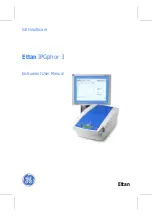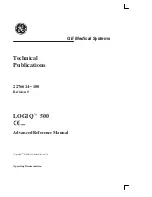
Operator's Manual
WP700Zi-OM-E-RevA
460
If the channel analysis method selected is
Channel Emulation
, the DDA will perform PRML channel emulation to
determine the location of problems in the data field. Often, there is a delay between the end of valid data and the
disabling of the Read Gate. It is generally not meaningful to analyze this area of a sector for problems. In order to
avoid analyzing this area, you can specify the number of PRML samples between the end of valid data and Read
Gate being disabled in the
Ignore Last Samples
data entry field in the "Channel Setup" dialog.
Using the DDA's Equalization Filter
Disk drives generally have filters to remove noise and to shape the head signal. Without these filters, data would
not be properly recovered. The DDA provides a similar filter capability. The equalization filter available in the
instrument’s channel emulation can be used with all the channel analysis methods to clean up and shape the
signal, much like the channel chip will do.
It is recommended that unless the head signal has been equalized before being acquired by the DDA, the filter
should be applied. Otherwise false problems may be reported. If you have access to the equalized signal from the
drive, this signal can be provided to the DDA. The filter should not be used in this case. The following figure
shows the same signal before and after using the DDA’s filter.
Before and after filtering
As you can see, it would be very difficult to perform meaningful analysis of the "before" picture, because of noise.
Note that Maximum Likelihood (ML) Markers ("+" signs) and Level Markers (horizontal lines) are displayed in the
"after" picture. The ML Markers indicate the location of the ideal PRML sample values based on the DDA’s
channel emulation. The Level Markers indicate the vertical position of the PRML levels based on the amplitude of
the acquired PRML signal.
Selecting the Waveform Section to Be Analyzed
For the Analog Compare and Channel Emulation channel analysis methods, you can specify selective areas of
the head signal for analysis by using the Analyze Region cursors or the drive’s Read Gate signal, or both.
As discussed above, it is important for the DDA to be able to analyze the VCO Synch signal at the beginning of
the region it is analyzing. If Read Gate is used to determine which head signal sections to analyze, this will not be
a problem, since the DDA will use Read Gate to identify the location of VCO Synch. If Read Gate is not used, it is
important, by means of the Analyze Region cursors, that the beginning of the head signal section analyzed be
very near the beginning of VCO Synch.
The following figures show the areas of the waveform to be analyzed, with the different combinations of the
Analyze Region cursors or Read Gate, or both, enabled. The Analyze Region cursors, if enabled, generally
specify the outer-most boundaries of the data to be analyzed. They are particularly useful if Read Gate is not
available or if only a subset of several Read Gate true sections captured is to be analyzed; for example, a single
sector within several captured, or excluding the ID field. Within the area designated by the markers, if Read Gate
is specified, only the regions of the Head Signal during which Read Gate is true are analyzed (as shown in Case
1) while all others are ignored.
Содержание DDA 7 Zi series
Страница 1: ...Operator s Manual WavePro SDA and DDA 7 Zi Series Oscilloscopes ...
Страница 2: ... L R R H HUD RU D D ...
Страница 41: ...Operator s Manual WP700Zi OM E RevA 40 The detachable WavePro Zi front panel ...
Страница 376: ...WavePro 7Zi 375 WP700Zi OM E RevA Absolute Offset Relative ...
Страница 439: ...Operator s Manual WP700Zi OM E RevA 438 ...
Страница 440: ...WavePro 7Zi 439 WP700Zi OM E RevA ...
Страница 544: ...Thank you for purchasing a WavePro SDA or DDA 7 Zi Oscilloscope ...
















































